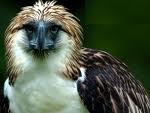The Philippine Eagle Foundation (PEF) is a non profit organization dedicated to saving the endangered Philippine Eagle, and is composed of plucky volunteers like retired Lt. Gen. Hotchkiss the foundation president who is solely responsible in preserving, breeding and caring for the birds.
Dr. Domingo Tadena, the veterinarian and the deputy director for captive breeding and has been with the PEF since it began in 1987 and Jo Victoria Kristy Cruz as volunteer for PEF field research team which use their time in taking comprehensive approach to conservation, engaging in research, off site and on site protection, community based efforts, public education to promote greater understanding and achieve results in the preservation of the eagle and its habitat.
All three, share a passion for caring the Philippine Eagle, a bird often cited for its bravery, fidelity and intelligence; no wonder it is the national bird of the Philippines. Two major threats to its survival which are hunting and deforestation.
Hotchkiss points out that forest cover is crucial to Philippine Eagles. Without it, they are unable to find food and build nests to breed, hence, the decline in population. Habitat and key prey populations are rapidly disappearing, likewise due to deforestation. Hence, the thrust towards environment conservation is combined with the drive to save and propagation the magnificent birds.
The hunting and shooting of the Philippine Eagle continue to persist, and eagles that have been turned over to PEF in recent years either had gunshot wounds or trapped illegally in the wild. Even birds that seemed healthy at the time of acquisition were found to have air gun pellets inside their bodies.
“Human persecution continues to be a threat to the viability of the wild eagle population,” add PEF executive director Dennis Salvador and express the hope that the Wildlife Act 9147 will protect them. Since 1992, the foundation has bred twenty two eagles. While births are greeted with media attention, there is little else available on them.
Education is key, and the PEF hopes they can address this. The PEF founded and operates the Center in Davao City. Currently home to thirty six Philippine Eagles and many other wildlife species. The PEC, in addition to being a breeding and research facility, has become an eco-tourism venue for visitors who want to see the Philippine Eagle up close.
The number of visitors has gone up and down rising to a high of 118,615 in 2002 and dropping to a low of 91,408 in 2005. Due to a lack of maintenance, the PEF faces the unpleasant dilemma of having to choose between allotting meager funds for the birds’ upkeep, or for that of the ground.
One of the project of Gen. Hotchkiss is the renovation of the PEC amenities, which aims to make it more modern and in tune with the environment. The PEF hopes to improve lectures on how to preserve nature and the Philippine Eagle through these renovations and offers partnerships to concerned companies and individuals to support the project.
These donations help provide for the bird’s food, veterinary care and maintenance for the entire year or the means to monitor nests and eagle chicks born in the wild. More importantly, the PEC hopes to attract volunteers to do fieldwork, administrative tasks, assist in managing special events such as the Philippine Eagle Week and to help then raise funds to improve their facilities for caring of the eagles. Currently, only 19 of the 36 Philippine Eagles at the PEC are sponsored by concerned individuals and organization.
The PEF need funds to feed and maintain the remaining eagles. To those who want to help, just log on to their website: http://www.philippineeagle.org or email: [email protected].
